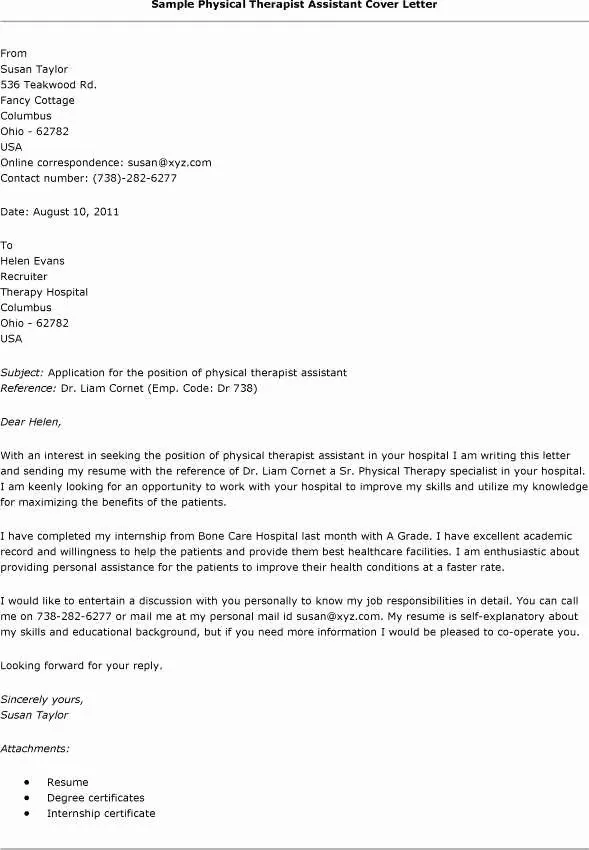Understanding the OT School Cover Letter
Applying to occupational therapy school is a significant step towards a rewarding career. A crucial part of your application is the cover letter. This document provides a platform for you to introduce yourself beyond the confines of your resume and academic transcripts. It’s your opportunity to express your passion for occupational therapy, highlight relevant experiences, and showcase your personality. A well-crafted cover letter can significantly increase your chances of acceptance, setting you apart from other applicants. It’s not just a formality; it’s a vital tool to demonstrate your suitability for the program. The cover letter allows you to tell your story, explaining why you’re drawn to occupational therapy and how your unique background and experiences make you a strong candidate. Think of it as your first impression, a chance to make a compelling case for why you belong in their program.
Key Components of an Occupational Therapy Cover Letter
Your Contact Information and Date
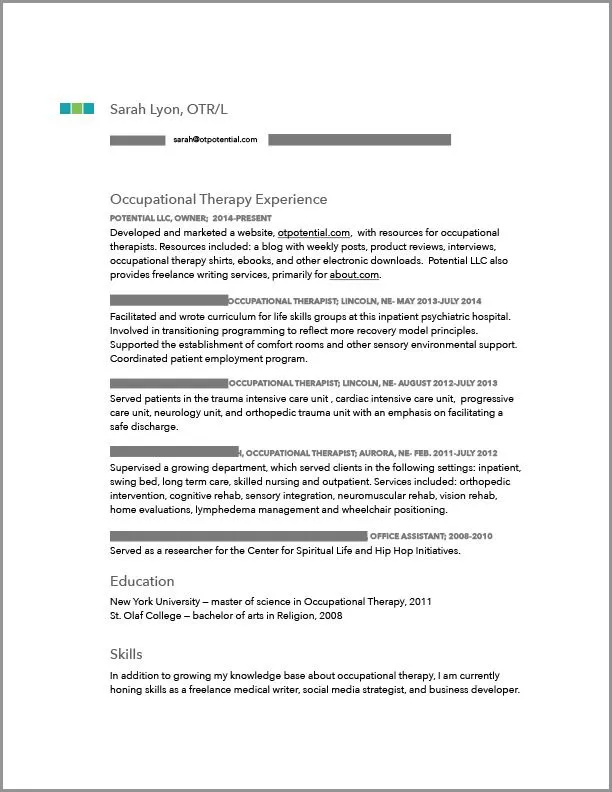
Begin your cover letter with your contact information: your full name, address, phone number, and email address. Following this, include the date you are writing the letter. Ensure that your contact information is accurate and professional. Double-check your email address for any typos, as this is how the admissions committee will contact you. The date is essential for record-keeping purposes and demonstrates that the letter is current. Place this information at the top left or right of the page, adhering to standard business letter format. This sets a professional tone from the beginning.
The Introductory Paragraph
The introductory paragraph is your first chance to grab the reader’s attention. Start by clearly stating the purpose of your letter: to apply to the occupational therapy program at their institution. Mention where you learned about the program (e.g., their website, a career fair, a professor). Then, briefly introduce yourself and express your strong interest in occupational therapy. Highlight one or two key experiences or qualities that make you a good fit for their program. Make it concise, engaging, and focused. Your goal is to make the admissions committee want to learn more about you. This first paragraph sets the tone for the rest of the letter, so make it count. Showing genuine enthusiasm is critical, as is demonstrating you understand the core values of the profession.
Highlighting Your Experiences
This is the section where you showcase how your experiences align with the demands of occupational therapy. Describe experiences that have shaped your interest in occupational therapy and demonstrate your understanding of the field. This could include academic achievements, volunteer work, observation hours, or any other relevant experience. Use specific examples to illustrate your skills and qualities. It’s not enough to say you have good communication skills; provide an instance where you used them effectively. The admissions committee wants to see what you have done and how you have grown from those experiences. Make sure to tailor your examples to the specific program you are applying to, if possible. They will appreciate it if you are showing genuine interest in their program and are not just sending a generic letter.
Academic Achievements
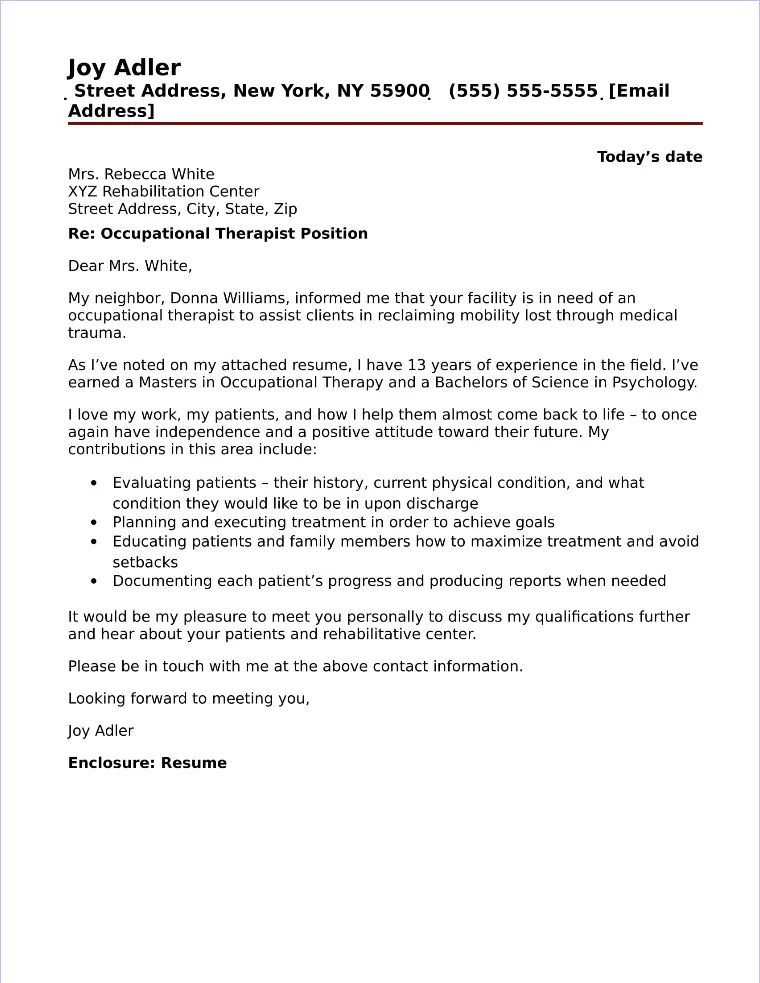
Briefly mention your relevant academic achievements, such as your GPA, any honors you’ve received, or specific courses that align with occupational therapy. If you have a strong academic record, it’s crucial to highlight it. However, don’t just list your grades; explain how your academic performance demonstrates your ability to succeed in a rigorous graduate program. Mention any research experience or academic projects that are related to the field. Frame your academic achievements within the context of your broader application. Connect your academic strengths to the skills and knowledge required for occupational therapy. This helps show how you are prepared to handle the demands of the curriculum.
Volunteer Work and Observation Hours
Volunteer work and observation hours are critical components of your application. Describe your experiences shadowing occupational therapists or volunteering in settings where you interacted with individuals who could benefit from OT. Detail the types of tasks you performed, the skills you developed, and the insights you gained about occupational therapy. Focus on how these experiences have solidified your interest in the profession. Quantify your experiences whenever possible; for example, mention the number of hours you volunteered or the number of patients you observed. Use specific examples of patient interactions to illustrate your empathy, problem-solving skills, and understanding of the therapeutic process. Emphasize any challenges you faced and what you learned from them.
Skills and Qualities
Identify and showcase the skills and qualities that make you a strong candidate for occupational therapy. These might include communication skills, empathy, problem-solving abilities, critical thinking, time management, and teamwork. Use examples from your experiences to illustrate these skills. For example, describe a situation where you had to communicate complex information to a patient or collaborate with a team to solve a problem. Explain how these skills are essential for an occupational therapist and how you have demonstrated them in the past. Show, don’t just tell; providing concrete evidence makes your claims more credible and compelling. Relate these qualities to the specific requirements and values of the OT program to demonstrate you understand the program’s ethos.
Demonstrating Passion for Occupational Therapy
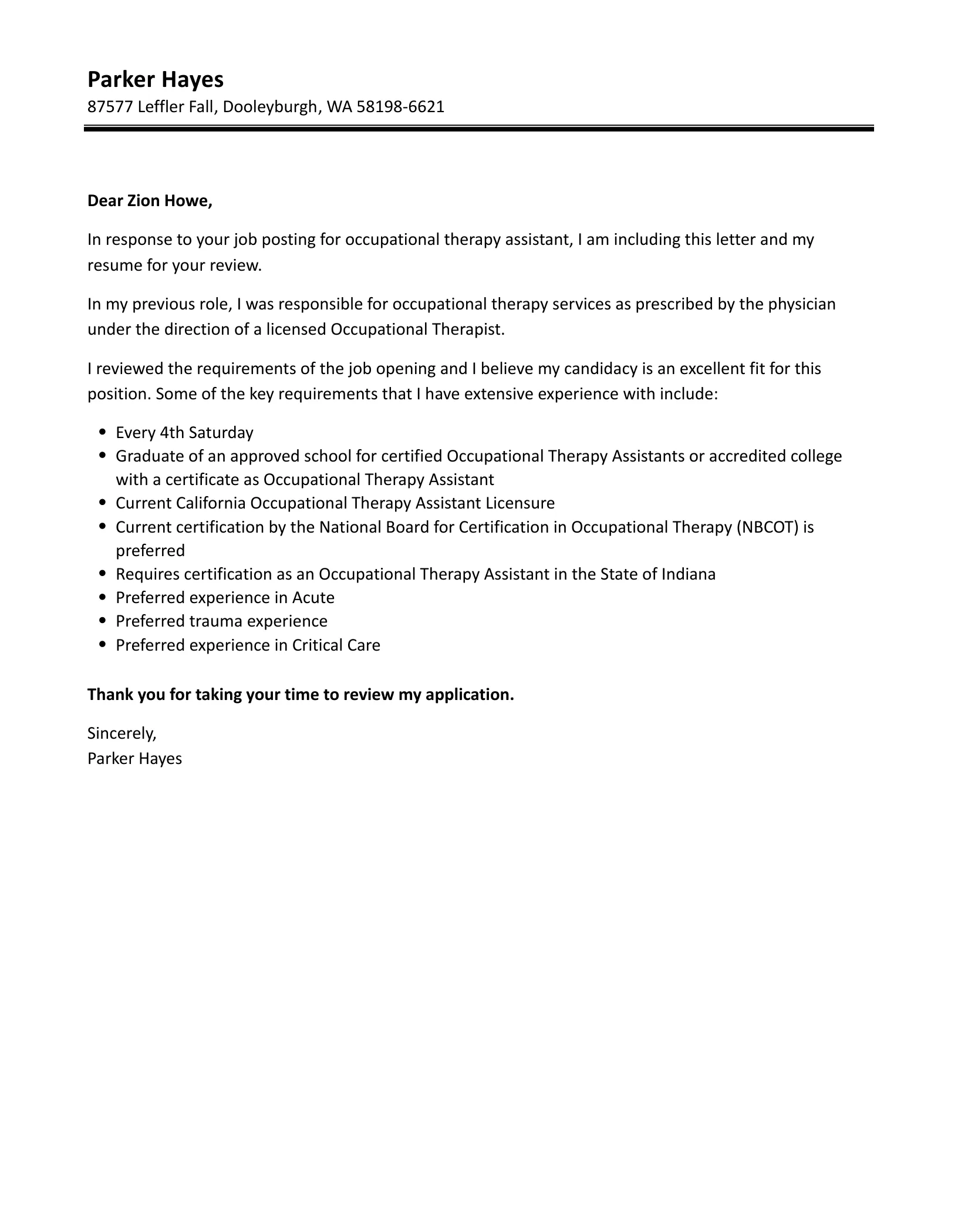
Your cover letter is the perfect place to express your passion for occupational therapy. Explain what specifically drew you to this profession. Did you have a personal experience, witness the impact of OT on someone’s life, or discover a specific area of interest? Share your reasons for pursuing this career path. Show genuine enthusiasm and a deep understanding of the values and principles of occupational therapy. Avoid generic statements. Instead, use specific examples to illustrate your passion. Connect your interest in OT to your long-term goals. Discuss how you see yourself contributing to the profession and the impact you hope to make on the lives of others. Your passion is a key factor that sets you apart from other candidates.
Showcasing Knowledge of the Profession
Demonstrate your understanding of the occupational therapy profession. Briefly discuss the scope of practice, the various settings where OTs work, and the populations they serve. Mention any relevant research you’ve done or articles you’ve read about occupational therapy. Highlight any specialized areas of interest within OT that align with your goals. Tailor your knowledge to the program you are applying to. Research the program’s mission, values, and areas of specialization. Refer to specific faculty members or research projects that interest you. This shows you’ve done your homework and are genuinely interested in their program. Demonstrating an understanding of current trends and issues in the field is also beneficial.
Concluding Your Cover Letter
The concluding paragraph should summarize your main points and reiterate your interest in the program. Thank the admissions committee for their time and consideration. Express your enthusiasm for the opportunity to study at their institution. End with a strong, confident statement of your commitment to the field. Ensure your conclusion leaves a positive and lasting impression. Make it clear that you are a strong candidate and eager to contribute to their program. A well-crafted conclusion reinforces the key messages of your letter and leaves the reader with a positive final thought.
Expressing Gratitude and Next Steps
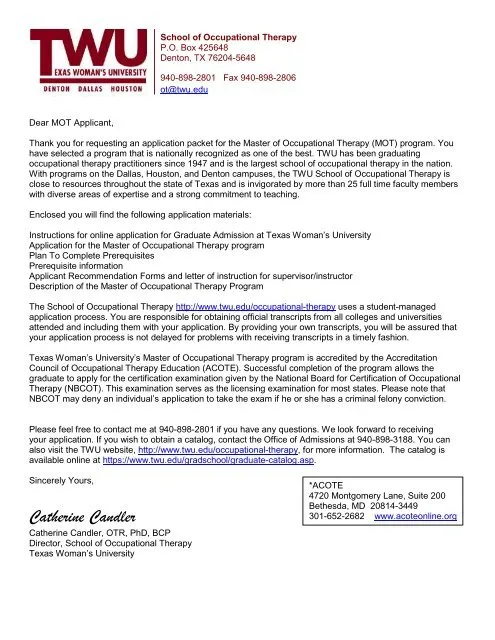
Express your gratitude to the admissions committee for considering your application. Thank them for their time and attention. Indicate your willingness to provide additional information or attend an interview. State that you look forward to hearing from them soon. Make sure to include a professional closing, such as “Sincerely” or “Respectfully,” followed by your typed name. Double-check that your contact information is accurate so the admissions committee can easily reach you. A polite and professional closing reinforces your positive attitude and commitment to the application process. End with a forward-looking statement to show your enthusiasm.
Proofreading and Formatting
Before submitting your cover letter, thoroughly proofread it for any grammatical errors, spelling mistakes, and typos. Ensure that the formatting is consistent and professional. Use a standard font and size, such as Times New Roman or Arial, 11 or 12 points. Check the letter for clarity, conciseness, and a logical flow of information. Ask a friend, family member, or career advisor to review your cover letter for feedback. A fresh pair of eyes can often catch errors you may have missed. A polished cover letter reflects your attention to detail and commitment to excellence. Proofreading and formatting are essential steps to ensure your application makes a positive impression. Make sure the language is clear, concise, and easy to understand.
In conclusion, a well-written cover letter is a critical component of your occupational therapy school application. By understanding the key components, highlighting your experiences, demonstrating your passion, and showcasing your knowledge, you can create a compelling cover letter that sets you apart from the competition. Take the time to craft a personalized and thoughtful letter, and you will significantly increase your chances of acceptance into your desired OT program. Good luck with your application!
